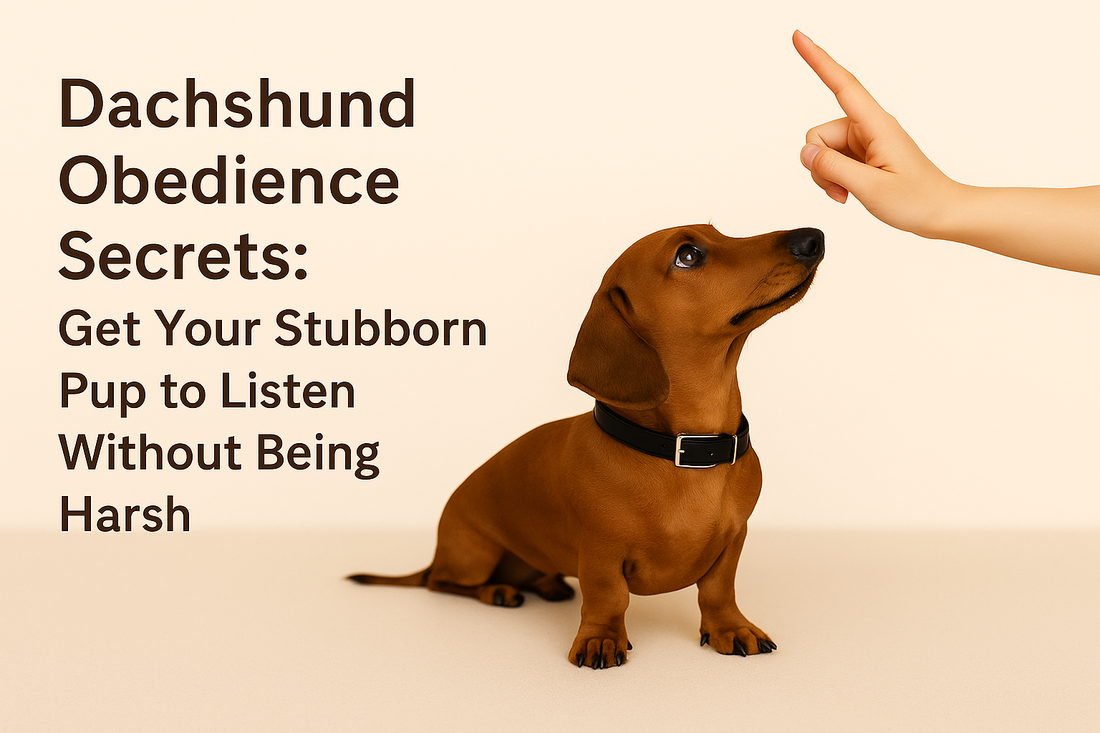
Dachshund Obedience Secrets: Get Your Stubborn Pup to Listen Without Being Harsh
Compartir
Does your Dachshund pretend not to hear you—especially when it matters most? You're not alone. These clever, willful pups are full of personality… and selective hearing. But with the right training approach, even the most headstrong Doxie can become a great listener—without fear or force.
Dachshunds may be pint-sized, but their confidence is huge. Bred to chase down badgers, they’re naturally independent, curious, and full of determination. But that same bold spirit can lead to stubborn behavior that frustrates even the most patient owner. The good news? You don’t need to “break” your Doxie’s will—you just need to speak their language.
Obedience doesn’t mean dominance. It means mutual respect, consistency, and rewards that make sense to your pup. When you learn how to work with your Dachshund’s instincts (not against them), you’ll unlock an entirely new level of connection and cooperation.
🎧 New Episode: Dachshund Obedience Secrets
1. Use Positive Reinforcement—Your Doxie Craves Rewards
Positive reinforcement is the secret sauce to training any dog, but it’s especially effective with Dachshunds. These smart little sausages are driven by food, fun, and attention—not fear. Instead of punishing bad behavior, reward the behavior you do want. That means every time your Dachshund sits on command, comes when called, or leaves something alone, you immediately mark that moment with praise, a treat, or both.
Make sure the reward is something your dog loves. Tiny pieces of boiled chicken, cheese, or special training treats work well. Use a happy tone of voice, enthusiastic body language, and be consistent. Short training sessions (5–10 minutes) once or twice a day are more effective than long drills.
Also, keep training sessions positive. If your Doxie gets distracted or frustrated, go back to an easier command to finish on a high note. Never end with scolding or confusion. They should look forward to training, not dread it.
🎁 Pro Tip: Check out our PawRoll Dachshund Slow Feeder Roller Toy – making mealtime interactive and fun.
2. Be Consistent—Your Dachshund Will Test You
Dachshunds are surprisingly sharp, and once they learn a loophole, they’ll exploit it. If your pup is allowed on the couch one day but gets scolded for it the next, they'll get confused—and likely ignore you altogether. Consistency is the glue that holds obedience training together.
Start by establishing clear household rules. Is your Dachshund allowed on furniture? Do they need to wait before eating? Which words mean what? Make a list and ensure everyone in the family uses the same commands and enforces the same boundaries.
Dogs don’t speak English—they read patterns. So if the rules change depending on your mood or who’s watching, your Dachshund will tune out and do whatever they please. Consistency builds trust, and trust makes your pup more willing to listen—even when they’re tempted to chase that squirrel.
Also, keep in mind that Dachshunds don’t generalize well. Just because they know “Sit” in the kitchen doesn’t mean they’ll do it in the park. Practice commands in different places and with different distractions.
🎁 Pro Tip: Reinforce structure with our PawStride Doxie Reflective Harness & Leash – Designed for comfortable, controlled outings that support training.
3. Practice "Watch Me"—Build Focus First
Before your Dachshund can obey a command, they have to actually pay attention to you—and that’s not always easy. Between smells, sounds, and movement, the world is full of distractions. That’s why teaching “Watch me” is one of the most powerful obedience tools you can master.
Start by holding a treat between your fingers and raising it to your face. Say “Watch me” in a cheerful tone, and the moment your pup locks eyes with you—even for a second—reward them. Repeat this often, gradually increasing how long they hold eye contact. Eventually, you’ll be able to get your Dachshund’s attention with just your voice or a hand signal.
This command is especially useful before giving another cue like “Sit” or “Stay.” It signals to your dog that it’s time to focus and engage. It also builds trust and emotional connection, which are key for stubborn breeds like Dachshunds.
Once mastered, “Watch me” becomes your go-to cue in distracting environments. Whether you’re at the vet, on a walk, or introducing new people, getting your Doxie’s eyes on you first sets the stage for success.
4. Use Short Commands—Clarity Wins
Dachshunds respond best to short, simple, and consistent commands. While it’s tempting to explain things in full sentences (“No sweetie, please don’t chew the rug”), that just creates noise. Instead, focus on clear one-word cues like “Sit,” “Stay,” “Off,” or “Leave it.”
Each command should always mean the same thing and be paired with the same tone and hand gesture. For example, don’t say “Down” sometimes and “Lie down” other times—your dog will assume they’re different actions. Consistency in language builds faster learning.
Avoid repeating commands over and over (e.g., “Sit… sit… sit!”). This teaches your dog that they don’t need to respond the first time. Say the command once, and if they don’t obey, guide them into the position and then reward.
And remember, your tone matters more than you think. Dogs pick up on your emotions through your voice. Say commands with confidence—not frustration—and always praise when they get it right. If you're calm and clear, your Dachshund is much more likely to follow through.
Practice these commands in quiet, familiar spaces at first, then level up to busier locations to reinforce learning in real-world situations.
5. Make It a Game—Turn Stubbornness Into Playfulness
Dachshunds are natural-born hunters and problem-solvers. If training feels like a boring chore, they’ll disengage fast. But if it feels like a game? They’re all in. Turning obedience practice into play is one of the smartest ways to outwit your Doxie’s stubborn streak.
Incorporate commands into fun activities: hide treats and ask your pup to “Find it,” or play indoor fetch where they must “Sit” before chasing the toy. Use praise and mini rewards to create a sense of excitement with each small success. The key is to keep energy high and expectations low—at first.
One fantastic exercise is the “Come” game. Put your pup in a sit-stay, then go a few feet away, crouch down, and call “Come!” in your happiest voice. When they arrive, reward like crazy. As your Dachshund gets better, increase the distance and add distractions.
By making obedience a positive, energetic experience, your dog will want to participate—not resist. Playfulness removes pressure and builds trust, which is exactly what a stubborn pup needs.
Games also provide mental stimulation, which reduces frustration and unwanted behaviors. A mentally tired Dachshund is a well-behaved one. 😄
Conclusion: Yes, Even Your Doxie Can Be Obedient
Your Dachshund isn’t being difficult to annoy you—they're just wired to think for themselves. But with consistency, kindness, and a bit of creativity, you can build a lasting bond based on mutual understanding. Obedience isn’t about control—it’s about connection. And the more you practice these gentle techniques, the more your Doxie will choose to listen, follow, and trust you.
Dachshund obedience doesn’t require harsh methods—just the right mindset and a little patience. Stick with it, and your stubborn pup will become your most loyal sidekick.
🐶 Related Articles
Amazing Fact about Dachshund Dog Breed
Want more tail-wagging tips? Visit our full blog at Doxie Blog for more Dachshund wisdom!
